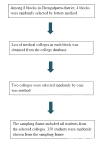Pre-hypertension and Associated Risk Factors Among Undergraduate Medical Students in Chengalpattu District: A Cross-Sectional Study
- PMID: 40656424
- PMCID: PMC12255907
- DOI: 10.7759/cureus.85896
Pre-hypertension and Associated Risk Factors Among Undergraduate Medical Students in Chengalpattu District: A Cross-Sectional Study
Abstract
Introduction Noncommunicable diseases (NCDs) are a major global health concern, with cardiovascular conditions being a leading contributor. Medical students are exposed to greater stress in terms of longer course duration as well as academic stress. Medical professionals adopt unhealthy lifestyles and end up developing chronic diseases at a younger age. This study screens such a vulnerable population for hypertension and aids in early diagnosis. Hypertension plays a key role in this burden, and its early stage (pre-hypertension) is recognized as a significant risk factor for developing full-blown hypertension and related complications. This study focuses on assessing the prevalence of pre-hypertension and identifying its associated factors among undergraduate medical students in South India. Aim To assess the prevalence of pre-hypertension among undergraduate medical college students in Chengalpattu district, Tamil Nadu, India. This study also aims to find out the various risk factors associated with pre-hypertension among undergraduate medical college students in Chengalpattu district. Methodology A cross-sectional study was conducted among 350 students from a medical college in Chengalpattu district. Participants were selected randomly, and data were collected using a pretested and structured questionnaire. Results Among the 350 study participants, 28% had pre-hypertension, 67.7% were normotensive, and 4.3% had stage 1 hypertension and were excluded from treatment. Pre-hypertension was significantly associated with age above 22 (AOR =1.833), in the final year (AOR = 2.107), smoking (AOR = 2.755), stress (AOR = 3.822), poor sleep (AOR = 1.983), inactivity (AOR = 2.738), and family history of hypertension (AOR = 2.186). Stress (AOR = 3.822) and smoking were the strongest predictors (AOR = 2.755). Stress and smoking were the strongest predictors but could not be quantified. Researchers could further explore this and create awareness. The study highlights the need for early intervention in high-risk groups. Conclusion The high prevalence of pre-hypertension and its strong links to both modifiable and demographic risk factors among medical students highlight the need for timely and focused preventive measures. The medical curriculum could adopt screening health campaigns and life skill education workshops. Early screening, lifestyle interventions, and stress management initiatives within academic settings are crucial in mitigating long-term cardiovascular risks and ensuring the health of future healthcare professionals.
Keywords: adolescent health; elevated hypertension; non-communicable disease; perceived stress; systemic hypertension; young adults.
Copyright © 2025, Syed et al.
Conflict of interest statement
Human subjects: Consent for treatment and open access publication was obtained or waived by all participants in this study. Animal subjects: All authors have confirmed that this study did not involve animal subjects or tissue. Conflicts of interest: In compliance with the ICMJE uniform disclosure form, all authors declare the following: Payment/services info: All authors have declared that no financial support was received from any organization for the submitted work. Financial relationships: All authors have declared that they have no financial relationships at present or within the previous three years with any organizations that might have an interest in the submitted work. Other relationships: All authors have declared that there are no other relationships or activities that could appear to have influenced the submitted work.
Figures
References
-
- Noncommunicable diseases. [ Feb; 2025 ]. 2024. https://www.who.int/news-room/fact-sheets/detail/noncommunicable-diseases https://www.who.int/news-room/fact-sheets/detail/noncommunicable-diseases
-
- Cardiovascular diseases (CVDs) [ Feb; 2025 ]. 2021. https://www.who.int/news-room/fact-sheets/detail/cardiovascular-diseases... https://www.who.int/news-room/fact-sheets/detail/cardiovascular-diseases...
-
- Hypertension. [ Feb; 2025 ]. 2023. https://www.who.int/news-room/fact-sheets/detail/hypertension https://www.who.int/news-room/fact-sheets/detail/hypertension
-
- World Health Day 2013: measure your blood pressure, reduce your risk. [ Feb; 2025 ]. 2013. https://www.who.int/news/item/03-04-2013-world-health-day-2013-measure-y... https://www.who.int/news/item/03-04-2013-world-health-day-2013-measure-y...
-
- Prevalence and risk factors for prehypertension and hypertension in five Indian cities. Singh RB, Fedacko J, Pella D, et al. https://www.researchgate.net/publication/264391042_Prevalence_of_and_ris.... Acta Cardiol. 2011;66:29–37. - PubMed
LinkOut - more resources
Full Text Sources


